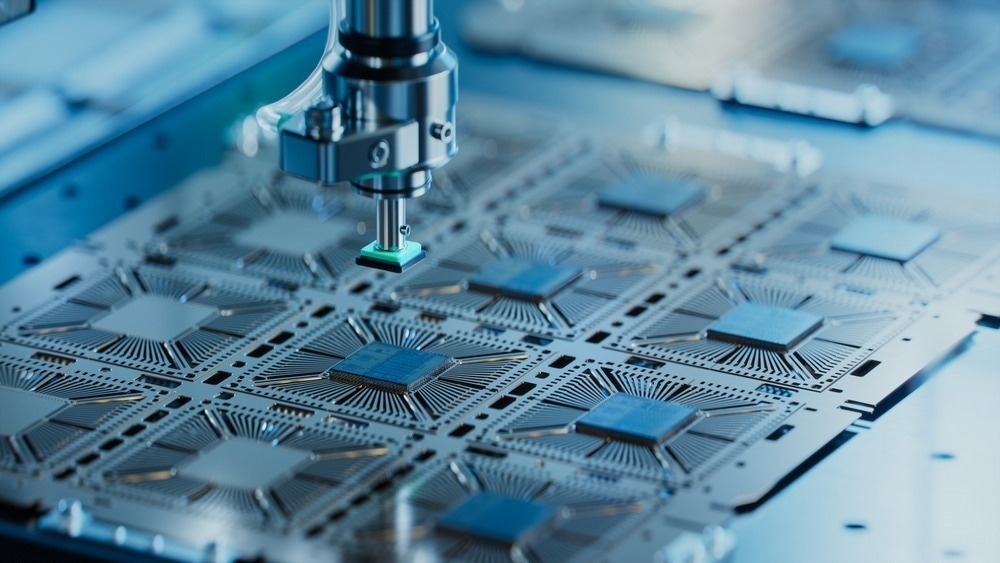A semiconductor is a material with electrical conductivity between that of a conductor (like copper) and an insulator (like glass). Unlike conductors, which allow electricity to flow freely, and insulators, which block it, semiconductors can be precisely controlled to regulate electrical current.
This ability to control conductivity makes semiconductors fundamental to modern electronics. But which materials exhibit this property, and how do they work?
Image Credit: IM Imagery/Shutterstock.com
The term “semiconducting” was first used in the late 18th century by Italian scientist Alessandro Volta, a pioneer of power and electricity. Decades later, English scientist Michael Faraday documented the first observed semiconducting effect in silver sulfide.
However, the true revolution in electronics occurred with the invention of the transistor in the mid-20th century.
For a more in-depth look at the evolution of semiconductor technology, check out this article:
A History of the Semiconductor Chip
How Does a Semiconductor Work?
Band Theory: The Foundation of Semiconductor Behaviour
The electrical properties of materials are governed by their energy bands.
In conductors, the valence band (which holds electrons) and the conduction band (where electrons move freely) overlap, enabling easy electron flow. Insulators, by contrast, have a large band gap between these bands, making it nearly impossible for electrons to jump into the conduction band.
Semiconductors sit in between, with a moderate band gap. This allows some electrons to move to the conduction band under certain conditions, such as increased temperature or exposure to light.
At absolute zero, semiconductors behave like insulators because no electrons have enough energy to cross the band gap. However, at room temperature or higher, thermal energy excites some electrons into the conduction band, enabling limited conductivity.
This delicate balance is what makes semiconductors so versatile in electronic applications.
Common Semiconducting Materials and Their Properties
| Material | Chemical Symbol | Group in Periodic Table | Band Gap (eV) |
|---|---|---|---|
| Silicon | Si | Group 14 | 1.12 |
| Germanium | Ge | Group 14 | 0.66 |
| Gallium Arsenide | GaAs | Group 13-15 Compound | 1.43 |
| Silicon Carbide | SiC | Group 14-14 Compound | 2.3 – 3.3 |
| Indium Phosphide | InP | Group 13-15 Compound | 1.35 |
| Cadmium Telluride | CdTe | Group 12-16 Compound | 1.45 |
Doping: Enhancing and Controlling Conductivity
Pure semiconductors, like silicon or germanium, are known as intrinsic semiconductors and have limited conductivity. To make them more practical for electronic devices, impurities are introduced through a process called doping.
Doping modifies the number of charge carriers in the material:
- n-type semiconductors are created by adding elements like phosphorus or arsenic, which contribute extra electrons (negative charge carriers).
- p-type semiconductors are formed by introducing elements like boron or gallium, which create “holes” (positive charge carriers) in the valence band.
This controlled addition of impurities allows semiconductors to toggle between conducting and insulating states.
Classification of Semiconductors (Intrinsic/Extrinsic, P-Type/N-Type)
What are Semiconductors Used For?
Semiconductors are the foundation of nearly all electronic devices. They are used in key components such as transistors and integrated circuits (ICs).
Transistors: Switching and Amplification
A transistor is an electronic device that controls the flow of electrical current. It has three terminals: the base, collector, and emitter. By applying a small voltage to the base, a transistor can regulate a larger current flowing between the collector and emitter. This allows transistors to function as amplifiers or switches in electronic circuits.
Transistors are used to create logic gates, which perform basic Boolean operations such as AND, OR, and NOT. These gates process binary data, enabling computational tasks.
For instance, NAND gates, made from complementary metal-oxide-semiconductor (CMOS) transistors, can be combined to create any other type of logic gate. Modern microprocessors contain billions of these gates to execute complex instructions.
Integrated Circuits: Miniaturization and Performance
ICs are devices that incorporate multiple electronic components, including transistors, resistors, and capacitors, on a single semiconductor chip. ICs are categorized based on their complexity:
- Simple ICs: Handle basic tasks like amplification or switching.
- Complex ICs: Perform more advanced functions, such as data processing or memory storage.
- Very Large Scale Integration (VLSI) ICs: Contain millions or billions of transistors, such as microprocessors that integrate entire central processing units (CPUs).
The miniaturization achieved through integrated circuit technology has significantly reduced the size, increased the speed, and improved the energy efficiency of electronic devices. This has enabled the development of increasingly powerful and compact computing systems, from basic calculators to advanced artificial intelligence platforms.
As semiconductor technology has advanced, its applications have expanded across multiple industries.
Key Applications of Semiconductors
| Application | Description |
|---|---|
| Microprocessors | The brains of computers, smartphones, and other digital devices. |
| Memory Chips | Both volatile (RAM) and non-volatile (flash) storage. |
| Graphics Processing Units (GPUs) | For high-performance computing and gaming. |
| Solar Cells | Converting sunlight into electricity for renewable energy. |
| Light-Emitting Diodes (LEDs) | Energy-efficient lighting in homes, vehicles, and displays. |
| Transistors | Fundamental components in all electronic devices. |
| Radio Frequency (RF) Chips | Enabling wireless communication in smartphones and other devices. |
| Engine Control Units | Managing vehicle performance and efficiency. |
| Advanced Driver Assistance Systems (ADAS) | Enhancing safety and paving the way for autonomous vehicles. |
| Smartphones | Integrating multiple semiconductor-based components. |
| Smart Home Devices | Thermostats, security systems, and voice assistants. |
| Imaging Equipment | MRI, CT scanners, and ultrasound machines. |
| Wearable Health Monitors | Tracking vital signs and activity levels. |
| Sensors | Detecting temperature, pressure, and other environmental factors. |
| Power Electronics | Controlling and converting electrical energy in industrial applications. |


